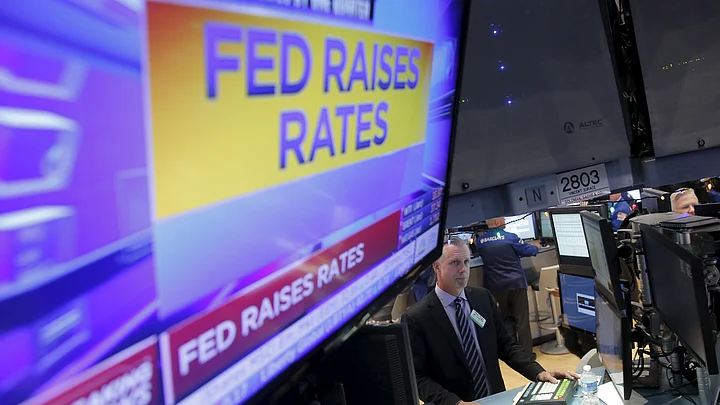The Federal Reserve hiked interest rates for the first time in nearly a decade on Wednesday, signaling faith that the U.S. economy had largely overcome the wounds of the 2007-2009 financial crisis.
The U.S. central bank’s policy-setting committee raised the range of its benchmark interest rate by a quarter of a percentage point to between 0.25 percent and 0.50 percent, ending a lengthy debate about whether the economy was strong enough to withstand higher borrowing costs.
“The Committee judges that there has been considerable improvement in labor market conditions this year, and it is reasonably confident that inflation will rise over the medium term to its 2 percent objective,” the Fed said in its policy statement, which was adopted unanimously.
The Fed made clear that the rate hike was a tentative beginning to a “gradual” tightening cycle, and that in deciding its next move it would put a premium on monitoring inflation, which remains mired below target.
In light of the current shortfall of inflation from 2 percent, the Committee will carefully monitor actual and expected progress toward its inflation goal. The Committee expects that economic conditions will evolve in a manner that will warrant only gradual increases in the federal funds rate.The Fed
New economic projections from Fed policymakers were largely unchanged from September, with unemployment anticipated to fall to 4.7 percent next year and economic growth at 2.4 percent.
The statement and its promise of a gradual path represents a compromise between those who have been ready to raise rates for months and those who feel the economy is still at risk.
“The Fed is going out of its way to assure markets that, by embarking on a “gradual” path, this will not be your traditional interest rate cycle,” said Mohamed El-Erian, Chief Economic Advisor at Allianz.
“Gradual” Tightening Cycle
The dollar firmed modestly after the rate rise. Based on interest rate futures markets, traders expected a second hike in April.
The median projected target interest rate for 2016 remained 1.375 percent, implying four quarter-point rate hikes next year.
To edge that rate from its current near-zero level to between 0.25 percent and 0.50 percent, the Fed said it would set the interest it pays banks on excess reserves at 0.50 percent, and said it would offer up to $2 trillion in reverse repurchase agreements, an aggressive figure that shows its resolve to pull rates higher.
Financial markets had expected the rate hike, bolstered by recent U.S. data showing job growth continuing at a strong pace.
A Dec. 9 Reuters poll showed the likelihood of a hike on Wednesday was 90 percent, with economists forecasting the federal funds rate to be 1.0 percent to 1.25 percent by the end of 2016 and 2.25 percent by the end of 2017.
The rate hike sets off an immediate test of new financial tools designed by the New York Fed for just this occasion, as well as a likely reshuffling of global capital as the reality of rising U.S. rates sets in.
The impact on business and household borrowing costs is unclear. One of the issues policymakers will watch closely in coming days is how long-term mortgage rates, consumer loans and other forms of credit react to a rate hike meant not to slow an economic recovery but nurse monetary policy back to a more normal footing.
The Fed emphasised it would move gingerly into its tightening cycle. That was enough to produce a unanimous vote on the policy-setting Federal Open Market Committee, as even members who had argued publicly for delaying a rate hike delay went along with Fed Chair Janet Yellen and other policymakers.
Wall St Rallies
U.S. stocks rallied in volatile trading on Wednesday after the Federal Reserve announced it is raising its key policy rate for the first time in nearly a decade.
Markets judged the Fed’s statement to be dovish, supportive of risk assets including equities.
The Dow Jones industrial average rose 164.68 points, or 0.94 percent, to 17,689.59, the S&P 500 gained 22.04 points, or 1.08 percent, to 2,065.45 and the Nasdaq Composite added 53.66 points, or 1.07 percent, to 5,049.01.
All but one of the ten major industry sectors of the S&P 500 traded higher, with utilities the largest percentage gainer on a more than 2-percent advance. Energy fell as crude oil prices continued to fall.
“This was a Santa Claus statement,” said John Augustine, chief investment officer at Huntington Wealth & Investment Management in Columbus, Ohio.
The Fed “gave savers a little bit more interest, investors a little bit more confidence in the economy, businesses a little bit more expectation of inflation,” he said.
What caught our attention the most was that it was a hawkish stance and a dovish statement.John Augustine, Chief Investment Officer, Huntington Wealth & Investment Management, Columbus, Ohio.
Indexes briefly turned lower after the decision was announced, but sharply changed direction within five minutes of the U.S. central bank’s statement.
Read more on the Fed hike from The Quint’s coverage here.
